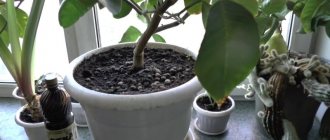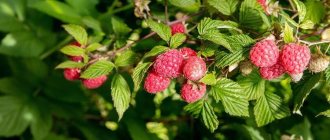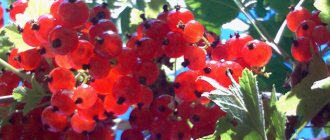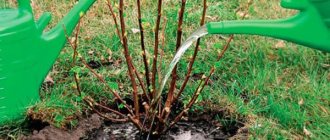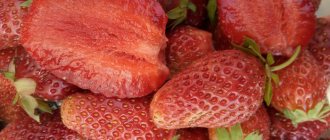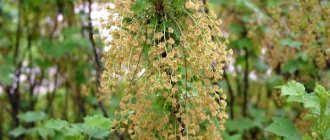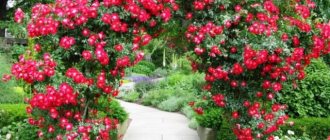We offer you tips for solving problems when growing berries in your garden - why strawberries do not bear fruit or bloom, with a description of the reasons for the decline in yield. We answer in detail what a beginner and an experienced gardener should do with this berry crop, how to choose and care for it on a private plot (dacha), to obtain stable fruiting.
Late boarding
The best time to plant strawberries is the second half of summer (late July - August). The deadline for planting strawberries in the middle zone is the beginning of September.
If you plant seedlings of this crop later, the plants simply will not have time to take root and grow a strong enough root system to bloom in the spring.
There is nothing “deadly” about this. If you care for your strawberry bushes correctly, they will most likely bloom and produce their first harvest next year.
Find more information about autumn planting strawberries in our material:
- Planting strawberries in the fall - when and how to properly plant seedlings in the beds
Strawberries can be planted not only in spring, but also in autumn. How to do it right?
What to do?
Follow the rules for caring for strawberries and wait until next year. If the bushes still do not bloom on time, look for the real reason.
External reasons for poor fruiting of strawberries
Abundant flowering and weak fruiting of garden strawberries, or, as they are often called, strawberries (although the term applies to a completely different plant, everyone is accustomed to this name), may be due to several reasons. Some of these reasons have nothing to do with the gardener and are related to unfavorable external conditions.
Poor pollination
Return frosts, which often affect strawberry blossoms, and prolonged rains greatly reduce the number of bees and other pollinating insects. In this case, the bushes are not pollinated enough and the berries do not set. Using insecticides against pests can also harm beneficial insects. Nowadays, this is a real problem - there are significantly fewer bees and bumblebees due to the use of chemicals in summer cottages.
Insufficient pollination can lead to a small number of ovaries in strawberries
To attract more beneficial insects to your site, you can:
- spray flowering bushes with warm water to which a few drops of anise or coriander oil have been added;
- spray with water with added sugar;
- plant honey plants (phacelia, alyssum and others) near the strawberry beds.
If you plant alyssum near strawberries, it will serve as an excellent honey plant.
Damage to flowers by raspberry-strawberry weevil
If the buds of flowering bushes dry out and fall off without setting berries, and in the inflorescences you can see drying pedicels with a flower that seems to have been bitten off, then we can confidently say that this is the work of the raspberry-strawberry weevil. A small black beetle most harms early varieties of garden strawberries: its females lay eggs in the buds.
Female raspberry-strawberry weevils lay eggs in the buds of garden strawberries
To combat weevil you need:
- in the fall, carefully collect old leaves from strawberry bushes and burn them;
- before wintering, loosen the soil around the garden strawberries well;
- plant garlic or other strong-smelling plants next to the strawberries;
- in the spring, spray the plantings with insecticides (Iskra M, Fufanon) strictly during the period of bud appearance and no later than 5 days before flowering. It is better to carry out the procedure in the morning so that the drug decomposes as much as possible and does not harm the predatory ground beetles that destroy harmful insects.
Frost
Not only bees suffer from frosts, but also the garden strawberry bushes themselves. Moreover, the damage is often invisible: the petals remain on the flower, only the middle darkens, the stigma dies and the berry does not set.
To prevent damage to the flowers, you need to cover the strawberry plantings with white spunbond.
Spunbond on strawberries not only protects the bushes from frost, but also repels birds
Last year in the spring, the strawberries bloomed very actively, and at the beginning of June there were frosts - we even had snow on our site. We were left without a harvest. This spring, I covered the beds in advance with thin (20 g/m2) spunbond, it protected both from cold weather and from drought - the bushes under the shelter suffered less from lack of moisture than other plants.
Planting this year
If strawberry seedlings are planted this spring, you certainly shouldn’t expect them to bloom in the same year.
- Planting strawberries in spring: step-by-step instructions for beginners
Is it so difficult to plant strawberries? Not at all.
Please note that strawberry seedlings are often sold already in bloom. However, if you are pursuing the goal of creating a good strawberry “plantation” on your site, it is advisable to pick off the flowers after planting. This must be done so as not to “distract” the plant from forming roots.
If your plans include a “disposable” vertical strawberry bed, then it is quite possible to leave the seedlings as is. The main thing is not to forget about feeding.
In a word, if strawberries planted in May do not bloom in May, there is no need to worry - everything is going according to plan!
What to do?
Wait and follow all the rules for growing strawberries.
How to properly pollinate strawberries?
Pollination in protected ground has nuances, while open plantings are pollinated naturally.
In the greenhouse
When growing cultivated plants in greenhouse conditions, insects cannot get inside the structure to pollinate the flowers. Air masses carrying pollen also do not have access there. In this regard, the process is carried out using an artificial method. Hand pollination (using a brush) in a greenhouse is not practical as it may take too long. The simplest solution, if the outside air temperature allows, is to open the opposite openings, creating a draft. At the same time, their prolonged opening creates access for insects to greenhouse plants.
The next solution, which is popular if it is not possible to create a natural draft, is to use a fan with a cold jet. The fan can be moved around the greenhouse or installed several times. For a greenhouse of 100 m², 3 pieces are enough. They are turned on for 3 hours during the flowering period.
If the greenhouse is huge, it is advisable to organize the presence of hives with bees in it. There is one hive per 1 hectare. In a smaller greenhouse, bees will have to be released. With this method, the gardener runs the risk of being stung, but this method is still popular, since strawberries are pollinated most efficiently with it - up to 95%.
Important! Artificial pollination is carried out only with open buds, so that the procedure is more effective. The process itself is recommended to be carried out in the morning.
In the open ground
When growing the crop in question in open ground, there are no problems with pollination. Insects and wind successfully cope with this task. To attract pollinating insects, you can plant flowers near the strawberry plantings that bloom simultaneously with the crop being grown.
If the berries grow on large plots of land, then gardening experts recommend installing hives with bees and bumblebees near the plantings
The most popular means of attracting bees to a strawberry bed is honey water. Dissolve 1 tbsp in 1 liter of water. l. honey and spray plantings with flowering plants. The same method can be used in a greenhouse with open openings.
Did you know? One bee colony is capable of pollinating almost 0.1 hectares of planting. Strawberries are a good supporting honey plant for them.
Incorrect planting depth
A common reason why a strawberry plant does not bloom or bear fruit is incorrect planting depth.
The strawberry plant has what is called a heart. New shoots and flower stalks grow from it, so you can’t bury it in the ground - there simply won’t be any flowers and, as a result, the strawberries won’t produce a harvest.
On the other hand, you can’t completely expose your heart either. The plant will weaken and, quite possibly, will not bloom either.
What to do?
If the plant is planted too high, add soil to the roots. If it is too deep, on the contrary, dig it up so that the soil is at the right level.
Weedy or unsuitable variety for the region
In the absence of proper care, weed varieties appear on strawberry plantations that do not bloom and do not produce crops. The source of their reproduction is considered to be the planting of garden strawberry tendrils of unknown origin and seed propagation of the crop. Experienced gardeners recommend not to engage in the seed method of growing strawberries, since it does not preserve the technical characteristics of the original variety.
Weeds also appear on plantations in cases where unpicked ripe berries remain on the bushes. Their seeds spread throughout the area, germinate and choke out fruiting strawberry varieties. Of all the weed varieties, Bakhmutka, Zhmurka, Podveska and Dubnyak are dangerous for garden strawberries. They are characterized by a rapid growth rate and aggressive barn formation.
When choosing a strawberry variety for your plot, a gardener should pay attention to its frost resistance characteristics. Lack of harvest is a consequence of an incorrectly selected option for your region
Bushes that are frozen in winter develop poorly and do not form flower buds.
Nitrogen overdose
Another possible reason why strawberries don’t bloom is that you “overfed” them with nitrogen and they became fattened.
When adding mineral fertilizers, do not forget that this must be done strictly according to the instructions. An overdose of nitrogen leads to the fact that the plant actively grows green mass and does not feel the need to take care of “procreation.” If you notice that strawberries are actively growing, but no flowers are appearing, most likely the problem is due to improper application of fertilizers.
What to do?
Temporarily stop fertilizing and water the strawberry bed well so that the nitrogen is quickly washed out of the soil.
Lack of nutrition
It is impossible to make strawberries bloom without adding nutrients. Garden strawberries require both organic and mineral fertilizers. If the soil at the growing site is poor, fertilize the plants as follows:
- Fertilizers are applied for the first time in early spring, as soon as the snow melts. It is important to do this before the first leaves bloom. The first fertilizing must include nitrogen, which promotes the growth of green mass and shoot growth. Make a mixture, adhering to the following proportions: 1 tablespoon of ammonium sulfate and 2 cups of mullein per 10 liters of water. Bushes are watered with this solution at the rate of 1 liter per 1 specimen.
- The next time garden strawberries are fertilized is in mid-May, before flowering begins. To improve the taste of the fruit at this time, fertilizers containing potassium are used. You can use mullein infusion or potassium nitrate in the amount of 1 teaspoon per 10 liters of water.
- To get a harvest of large fruits, another feeding is carried out at the stage of ovary formation. Use any complex mineral fertilizer, applying it using the foliar method.
See also
How many years can strawberries bear fruit in one place, terms and conditionsRead
Fertilizers consisting of natural ingredients - wood ash, iodine, bread crusts - are also considered useful.
Lack of nutrients
It is also possible that the strawberries are “undernourished.”
If you did not have time to fertilize in early spring, do it now, otherwise the bushes may not bloom this season.
What to do?
Add fertilizer. How to feed strawberries with “chemistry” and organic matter, as well as folk remedies, read our article:
- How to feed strawberries in spring
We tell you what is the best way to feed strawberries (garden strawberries) to get an excellent harvest.
Weed strawberries instead of garden ones
Or maybe you grew strawberries by seed? In this case, no one guarantees that from the purchased seeds you will grow garden strawberries and not weed ones.
The same situation can happen with seedlings purchased from unverified sellers. Under the guise of pineapple strawberries, they could very well sell you an ordinary “wild” strawberry that does not bear fruit, but grows quickly and takes over nearby “territories” allocated for beds with other crops.
In general, strawberry seeds are intended for breeding work, but not for quick harvest. It is advisable to propagate it with a mustache or buy seedlings. However, it is also possible to grow this crop from seeds. We have already told you how to do this in 4 steps.
What to do?
If the strawberry has taken root well, but has not bloomed (or has bloomed, but bears very small fruits) for two or even three seasons in a row, feel free to dig it up before it clogs the entire garden.
Reasons for mustache instead of flowering
Reasons for mustache instead of flowering
The list of factors why strawberries do not bear fruit but grow mustaches includes:
- The fatting of an aged plot is one of the reasons why strawberries do not bloom but produce mustaches. Garden strawberries, which are more than five years old, have a low yield. What should you do if strawberries become fattened? It is necessary to replace strawberry plantings in a timely manner;
- Planting in August is also the reason why strawberries produce only runners instead of fruits. The negative side of autumn planting is the likelihood of the plant freezing during seasonal frosts. In the case when the strawberries do not have flower stalks and they begin to grow fat, they should be planted in the first half of the year, and an insulated shelter should be made for planting;
- Improper care also affects the fact that strawberries do not bloom but produce mustaches. Strawberries bloom best in the 3rd year. Proper care of planting is necessary at all stages of development. In August, when flower buds are being laid, you should monitor the temperature and humidity. Also, in order to prevent fattening, which prevents the bush from thriving, the plantings must be fertilized and covered for the winter;
- Insufficient pollination occurs during the long rainy season or when insects are absent. Recommendations on what to do if strawberries bloom but do not bear fruit are self-pollination or waiting for pollinating insects.
You can combat the problem when strawberries sprout a mustache but there is no ovary by refusing to use insecticides before pollination, as well as by controlling the moisture level;
- The appearance of pests is another reason why there is no ovary and strawberries grow mustaches. The strawberry weevil, a pest that damages the buds, most often settles on strawberries. In this case, what should you do if strawberries are fattening? It is treated in the morning with Fitoverm at the stage of bud formation so that it does not have time to grow an antennae.
There may be several reasons why strawberries produce only whiskers instead of fruits. Frequent recommendations from gardeners who claim that if a strawberry bush does not bear fruit, it should be removed from the garden, can be considered not entirely correct. Each of the problems of what to do when strawberries bloom but do not bear fruit can be solved in an appropriate way, which will help return the plant to a healthy state of fruiting, and not just throw it away, because it is quite possible that it is capable of blooming normally and producing good harvests.
Hypothermia
Another probable option is that the strawberry heart froze over the winter. This is possible in frosty, snowless winters, especially if the bed was not well covered.
The May return frosts could also be the cause.
What to do?
Unfortunately, there is nothing you can do to help strawberries this season. However, do not rush to “evict” her from the garden. Perhaps it will come to its senses over the summer and produce a harvest next year.
Be sure to cover the plants well for the winter and during return frosts, and also help the snow to linger on the site in every possible way.
Strawberry care
In subsequent years, the soil under the strawberries was still kept moist, but without excessive moisture. After each watering, I mulched open areas of the soil, including paths. I fed it 2 times during the growing season, the last, 3rd time - before the plants went into retirement.
The first time I fed it in the bud phase - the first flowers - with an organic solution. I poured the nutrient solution carefully, from the side of the wide path, under the roots of the plants so that it did not get on the flowers, buds, or leaves. Consumption – one bucket of solution for 6-12 strawberry bushes. Organic fertilizers (manure or bird droppings) were diluted in a ratio of 1:10 – 1:12. Sometimes in the first fertilizing I added nitroammophoska at 40-50 g/sq.m. m. After fertilizing, be sure to water it.
I mulched the row with fine mulch in a layer of 2-3 cm, lifting the leaves. The wide path was mulched with cut straw, green stems of annual weeds, and mowed dried green manure. The ground was covered with a layer of up to 5 cm. Before the mass flowering of strawberries, it is necessary to mulch the bushes: the berries in the ridge and on its sides will then fall on clean mulch.
After the first harvest of strawberries, I carried out the 2nd feeding. For 1 sq. m of area for irrigation, scattered 1.5-2.0 cups of ash under the bushes on the side of the wide path or watered with infusion of ash (200 g/10 l of water). In other years, I added kemira or a mixture of microelements.
During the first 2 years, I tore off all the tendrils, giving the strawberry bushes the opportunity to take root well and form healthy plants. From the age of 3, she tore off her mustache on the side of the wide paths. I directed 2-3 strong whiskers from the bush to the middle of the line. When the rows of strawberries closed and became dense, thinning was carried out in the spring or autumn after harvesting. I dug up strawberry bushes that had aged early, had little fruit, were ugly, and were forming small berries. I left 3-4 bushes per linear meter. This thinning was done every 4 years. Sometimes, after disinfection with 1% potassium permanganate, a healthy, well-developed mustache was planted (directed) into a free space. The feeding area for the remaining bushes increased. Strawberry bushes formed larger berries and a lush above-ground mass.
The third feeding of strawberries was carried out at the end of September. During the last watering I applied phosphorus-potassium fertilizers (no more than 60-70 g/sq. m.). At the same time, I tried to trim off old, withered, diseased leaves creeping along the ground. If there was no time left for this procedure, then I tried to cover them with mulch, where they rotted until spring.
During the growing season, the main thing for adult strawberries is sufficient watering, but not excessive. Otherwise, the roots become rotten and the bush dies, infecting nearby ones. And the second condition is sparse landings. It is necessary to thin out unnecessary bushes, especially if the initial plantings were thickened (every 10 cm).
Around the 4th - 5th year, I left the most developed strawberry tendrils with normal, not elongated internodes and directed them onto a wide path. Over the course of 1-2 years, a row of young strawberry bushes appeared along the edges of the wide path, which were cut off from the old row in the fall. I dug up the old 2 rows. Before digging, I applied full mineral fertilizer. It is needed to quickly rot the remains of the mulch applied annually under the strawberries in the garden. The arrangement of strawberries changed from double-row to single-row. The distance between the rows was approximately 50, 40-50 cm. The mustaches were also torn off during this period, leaving 1-2 of the most developed ones, directed along the row. Strawberries bear fruit for another 4-5-6 years, forming high yields of healthy large berries.
The repairing strawberry has degenerated
If remontant strawberries grow in your garden, after a couple of seasons they may degenerate and stop bearing fruit.
If the bushes always gave a good harvest, you looked after them correctly, but this year they did not bloom, maybe this is the reason.
- Summer methods of propagating strawberries - with a mustache and dividing the bush
Propagating strawberries is not at all difficult. This garden crop is not capricious. We will talk about the most popular summer propagation methods.
What to do?
In this case, there is only one thing left - to update the strawberry plantings.
Why strawberries bloom, but do not bear fruit, produce only mustaches, a lot of foliage, but few berries: reasons
Summer residents often complain that in past seasons the Victoria harvest was abundant, but now the flowering has weakened, and the berries have become smaller, sour, and ugly. Or why strawberries bloom, but the berries do not set.
- Often this is due to age. For berry crops of garden varieties that have been growing for more than 4-5 years, the yield inevitably falls and the plantings need to be updated.
- Also, the reason for this is that strawberries lose their varietal qualities ahead of time.
- There is also the concept of varietal waste. If, from the moment of correct planting in the main place in the garden, there were no special harvests on the bush for several years, then the wrong choice of strawberry variety is to blame. Seedlings purchased by chance at the market, despite the admonitions of the sellers, can often belong to weed species - “Dubnyak”, “Bakhmutka” or the so-called “Pendant” variety. Some of these species do not bloom at all, others have many empty flowers or the fruits are sour, small and crooked, even with excellent care. Such plants have an abundance of tendrils and grow very large. Such plantings must be removed.
- If the seedlings purchased from a nursery are of high quality, it means that the conditions on the site are not suitable for the variety, since it is capricious and demanding of care or is intended for a different growing region.
- It is also necessary to replant garden strawberry bushes to a new place in the garden, at least every 4-5 years.
- Take a closer look at the foliage and roots; perhaps the plant is sick.
We recommend that you take into account the description of the reasons from our article about the plant disease Fusarium. - Know exactly the characteristics of growing the acquired variety. The fact that you have been caring for a plant the old fashioned way for many years and everything was fine does not mean at all that new varieties will not require a special approach and a different arrangement of the bed.
There were many flowers on the bushes, but no berries were formed from them.
- This may be due to lack of pollination. This usually occurs during prolonged rainfall during the flowering period. Another problem is that there are fewer insects that consistently pollinate plants in your area, which is now a common phenomenon. Then there will be few ovaries on fruit trees and other subshrubs.
- It is recommended not to treat pollinated types of fruit and berry crops, including strawberries, with insecticides while they are in bloom. You can lightly spray the plant with an aqueous solution adding a few drops of anise essential oil, which, like coriander, attracts bees.
- Monitor the temperature in the spring, use covering material, agrofibre, fiber film during freezing so that the ovaries and buds do not die.
Pests and diseases
Certain diseases and pests may prevent strawberries from blooming and bearing fruit. Pests include strawberry weevils and nematodes, and diseases include powdery mildew and white or brown spot.
What to do?
Urgently save the plant from diseases and “attacks” of insects! How exactly to do this, read our articles:
- Top 5 most dangerous strawberry diseases
We learn to identify and treat the main diseases of strawberries (garden strawberries).
- Strawberry pests: how to recognize and fight
Garden strawberries (strawberries) are an attractive “target” for many pests, the most dangerous of which we will talk about today.
Fertilizing strawberries with yeast
Yeast fertilizer for strawberries gives incredible results
. It turns out that this nutrient mixture perfectly promotes the growth and fruiting of garden strawberries and other plants. Try one of the following compositions:
- the simplest recipe - add raw yeast (100 g) to a bucket of warm water (10 l) and stir, then leave for a day and add 0.5 l of the nutrient mixture to each plant;
- Dissolve 0.5 kg of live yeast in a 3 liter jar with warm water and let it brew for 3-4 hours. Then dilute the mixture in 25 liters of water and water the bushes with it at the root;
- Dilute 5 g of dry yeast in 0.5 liters of water and add 20 g of sugar (1 tbsp). After 2-3 hours, dilute the mixture with 25 liters of water and apply 1 liter of the composition under each plant;
- to 1 tbsp. dry yeast, add 2 g of ascorbic acid, 50 g of sugar, a little earth, 5 liters of warm water and let it brew for 24 hours. Before applying the fertilizer, it is diluted with 10 liters of water and a liter of the resulting mixture is applied under one bush.


